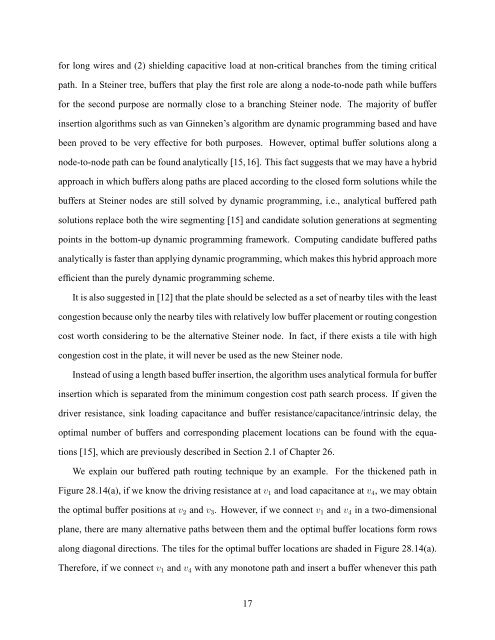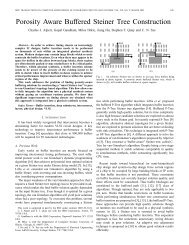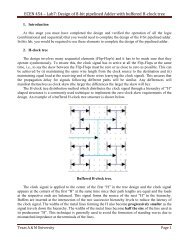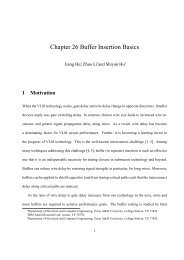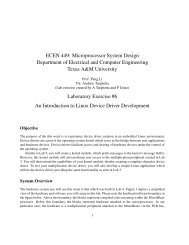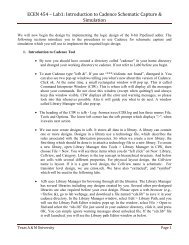Buffering in the Layout Environment - Computer Engineering ...
Buffering in the Layout Environment - Computer Engineering ...
Buffering in the Layout Environment - Computer Engineering ...
Create successful ePaper yourself
Turn your PDF publications into a flip-book with our unique Google optimized e-Paper software.
for long wires and (2) shield<strong>in</strong>g capacitive load at non-critical branches from <strong>the</strong> tim<strong>in</strong>g criticalpath. In a Ste<strong>in</strong>er tree, buffers that play <strong>the</strong> first role are along a node-to-node path while buffersfor <strong>the</strong> second purpose are normally close to a branch<strong>in</strong>g Ste<strong>in</strong>er node. The majority of buffer<strong>in</strong>sertion algorithms such as van G<strong>in</strong>neken’s algorithm are dynamic programm<strong>in</strong>g based and havebeen proved to be very effective for both purposes. However, optimal buffer solutions along anode-to-node path can be found analytically [15,16]. This fact suggests that we may have a hybridapproach <strong>in</strong> which buffers along paths are placed accord<strong>in</strong>g to <strong>the</strong> closed form solutions while <strong>the</strong>buffers at Ste<strong>in</strong>er nodes are still solved by dynamic programm<strong>in</strong>g, i.e., analytical buffered pathsolutions replace both <strong>the</strong> wire segment<strong>in</strong>g [15] and candidate solution generations at segment<strong>in</strong>gpo<strong>in</strong>ts <strong>in</strong> <strong>the</strong> bottom-up dynamic programm<strong>in</strong>g framework. Comput<strong>in</strong>g candidate buffered pathsanalytically is faster than apply<strong>in</strong>g dynamic programm<strong>in</strong>g, which makes this hybrid approach moreefficient than <strong>the</strong> purely dynamic programm<strong>in</strong>g scheme.It is also suggested <strong>in</strong> [12] that <strong>the</strong> plate should be selected as a set of nearby tiles with <strong>the</strong> leastcongestion because only <strong>the</strong> nearby tiles with relatively low buffer placement or rout<strong>in</strong>g congestioncost worth consider<strong>in</strong>g to be <strong>the</strong> alternative Ste<strong>in</strong>er node. In fact, if <strong>the</strong>re exists a tile with highcongestion cost <strong>in</strong> <strong>the</strong> plate, it will never be used as <strong>the</strong> new Ste<strong>in</strong>er node.Instead of us<strong>in</strong>g a length based buffer <strong>in</strong>sertion, <strong>the</strong> algorithm uses analytical formula for buffer<strong>in</strong>sertion which is separated from <strong>the</strong> m<strong>in</strong>imum congestion cost path search process. If given <strong>the</strong>driver resistance, s<strong>in</strong>k load<strong>in</strong>g capacitance and buffer resistance/capacitance/<strong>in</strong>tr<strong>in</strong>sic delay, <strong>the</strong>optimal number of buffers and correspond<strong>in</strong>g placement locations can be found with <strong>the</strong> equations[15], which are previously described <strong>in</strong> Section 2.1 of Chapter 26.We expla<strong>in</strong> our buffered path rout<strong>in</strong>g technique by an example. For <strong>the</strong> thickened path <strong>in</strong>Figure 28.14(a), if we know <strong>the</strong> driv<strong>in</strong>g resistance at v 1 and load capacitance at v 4 , we may obta<strong>in</strong><strong>the</strong> optimal buffer positions at v 2 and v 3 . However, if we connect v 1 and v 4 <strong>in</strong> a two-dimensionalplane, <strong>the</strong>re are many alternative paths between <strong>the</strong>m and <strong>the</strong> optimal buffer locations form rowsalong diagonal directions. The tiles for <strong>the</strong> optimal buffer locations are shaded <strong>in</strong> Figure 28.14(a).Therefore, if we connect v 1 and v 4 with any monotone path and <strong>in</strong>sert a buffer whenever this path17


